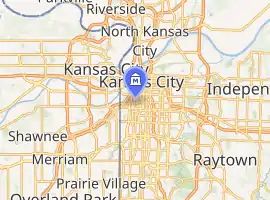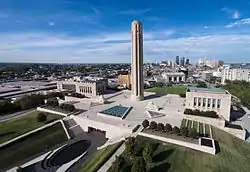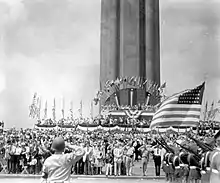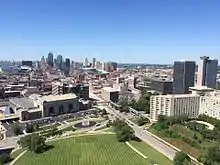National World War I Museum and Memorial
The National World War I Museum and Memorial of the United States is located in Kansas City, Missouri. Opened to the public as the Liberty Memorial museum in 1926, it was designated in 2004 by the United States Congress as America's official museum dedicated to World War I. The Museum and Memorial are managed by a non-profit organization in cooperation with the Kansas City Board of Parks and Recreation Commissioners.[3] The museum reopened to the public in December 2006 with an expanded, award-winning[4] facility to exhibit an artifact collection that began in 1920. The National World War I Museum tells the story of the Great War and related global events from their origins before 1914 through the 1918 armistice and 1919 Paris Peace Conference. Visitors enter the exhibit space within the 32,000-square-foot (3,000 m2) facility across a glass bridge above a field of 9,000 red poppies, each one representing 1,000 combatant deaths.[5]
.svg.png.webp) New logo in 2017, Intersections | |

| |
| Location | Kansas City, Missouri, United States |
|---|---|
| Nearest parking | Onsite (no charge) |
| Website | theworldwar |
National World War I Museum and Memorial | |
 Aerial photo of the National WWI Museum and Memorial with the Kansas City skyline. | |
| Location | Kansas City, Missouri |
|---|---|
| Coordinates | 39°04′49″N 94°35′10″W |
| Built | 1926 |
| Architect | Harold Van Buren Magonigle, Westlake Construction Company |
| Architectural style | Beaux Arts Classicism, Egyptian Revival |
| NRHP reference No. | 00001148 |
| Significant dates | |
| Added to NRHP | September 20, 2006[1] |
| Designated NHL | September 20, 2006[2] |
Mission
The declared mission of the museum and memorial is to be "dedicated to remembering, interpreting and understanding the Great War and its enduring impact on the global community." [6]
History
Liberty Memorial Association
Soon after World War I ended, a group of 40 prominent Kansas City residents formed the Liberty Memorial Association (LMA) to create a memorial to those who had served in the war. They chose lumber baron and philanthropist Robert A. Long, who had personally given a large sum of money, as president.[7] Others included:
- James Madison Kemper was treasurer of the association. For a short time in 1919 he was President of City Center Bank that was founded by his father, William T. Kemper. His brother, Rufus Crosby Kemper Sr., became president when he left to take over as president of Commerce Bancshares, also controlled by his father.
- J.C. Nichols, a real estate developer, was a lead proponent of the Liberty Monument.
- William Volker, businessman and philanthropist, helped the city acquire the land for the memorial.
- George Kessler, designer of the landscaping at the memorial.[8]
In 1919, the LMA spearheaded a fund drive that included 83,000 contributors and collected more than $2.5 million in less than two weeks (equivalent to $36.9 million in 2019), driven by what museum curator Doran Cart has described as "complete, unbridled patriotism".[9] There would not be the monetary problems that plagued the Bunker Hill Monument for the American Revolutionary War in Boston one century earlier.[10]

Dedications
In attendance at the groundbreaking ceremony on November 1, 1921, were 200,000 people,[9] including then-Vice President Calvin Coolidge, Lieutenant General Baron Jacques of Belgium, Admiral of the Fleet Lord Beatty of Great Britain, General Armando Diaz of Italy, Marshal Ferdinand Foch of France, and General of the Armies John Pershing of the United States, along with 60,000 members of the American Legion. The local veteran chosen to present flags to the commanders was a Kansas City haberdasher, Harry S. Truman,[11] who would later serve as 33rd President of the United States, (1945-1952). The finished monument was dedicated on November 11, 1926, by now 30th President Coolidge, in the presence of Queen Marie of Romania.[12] Coolidge announced that the memorial "...has not been raised to commemorate war and victory, but rather the results of war and victory which are embodied in peace and liberty…. Today I return in order that I may place the official sanction of the national government upon one of the most elaborate and impressive memorials that adorn our country. The magnitude of this memorial, and the broad base of popular support on which it rests, can scarcely fail to excite national wonder and admiration."[13]
Renovations
In 1935, bas reliefs by Walker Hancock of Jacques, Beatty, Diaz, Foch and Pershing were unveiled.[14]

In 1961 the monument was rededicated by President Harry S. Truman. The local effort to restore[15] the fading monument was headed by Armand Glenn the local head of the central district legion. Local company Hallmark provided support, and on November 11, 1961 on its 40th anniversary there was a large dedication ceremony held on the grounds of the memorial. 15,000 watched Truman preside over the service.
In 1981-1982, corresponding to its 60th anniversary, the building revealed new exhibits under improved lighting sources.[16]
The memorial was closed in 1994 due to safety concerns,[9] because aging had produced problems with drainage and the original construction. Local shopping malls voluntarily helped to put part of the museum collection on display while the memorial was unavailable.[9] When the poor condition of the building became an embarrassment for the city,[9] Kansas City voters in 1998 passed a limited-run sales tax to support the restoration.[17] Plans were also made at this time to expand the site with a museum to accommodate the LMA's growing collection. Local, national, and international support for this undertaking provided $102 million (equivalent to $160 million in 2019), ultimately revealed at its 2006 reopening.[18]
In 2004, Congress named the Liberty Memorial museum as the nation's official World War I Museum, and construction started on a new 80,000-square-foot (7,400 m2) expansion and the Edward Jones Research Center underneath the original memorial. The year that this was completed, Liberty Memorial was designated a National Historic Landmark on September 20, 2006.[19]
A substantial renovation, with a cost estimate of $5 million was undertaken beginning in December 2011.[20] It included $170,000 in energy-efficiency upgrades to the building as well as improvements to the artificial flame atop the tower.[21] After several months of dormancy, the flame was "relit" on February 1, 2013. Other portions of the overall renovation included security upgrades along with repairs to certain limestone sections and brush removal.[20][21]
An addition planned for completion in 2018 is the Wylie Gallery, which will occupy existing unused space on the east side of the museum building.[22] It is part of a $6.4 million upgrade made possible by a fundraising campaign[23] coinciding with the tenth anniversary of the museum's 2006 reopening. The gallery will house traveling exhibits from around the world.[22][23]
Current designation
On December 19, 2014, President Barack Obama signed legislation recognizing it as "a 'World War I Museum and Memorial'", which resulted in redesignation of the entire site as the National World War I Museum and Memorial.[24]
Design
The national design competition was managed by Thomas R. Kimball, a former president of the American Institute of Architects (AIA). After discord within the organization locally, the design contract was finally awarded to New York architect Harold Van Buren Magonigle.[n 1][25]

Liberty Tower
The main doors at the bottom of a large set of stairs are made from ornamental bronze, and the walls of the first floor lobby are finished in Kasota stone,[26] which was quarried in Kasota, Minnesota. The first floor corridor and the grand stairway are finished in travertine that was imported from Italy.[26] At night, the top of the 217-foot (66 m) tall memorial tower emits a "flame effect", steam illuminated by bright red and orange lights. This effect creates the illusion of a burning pyre and can be seen for some distance. Overall, the memorial rises 265 feet (81 m) above the surrounding area.[27]
External buildings
The tower and buildings are designed in the classical Egyptian Revival style of architecture with a limestone exterior.[26] The foundation was constructed using sawed granite, and the exterior ground level walls are made of Bedford stone. On opposite sides of the main deck of the Liberty Memorial are Exhibition Hall and Memory Hall.[28] Memory Hall includes murals originally painted for the Panthéon de la Guerre in Paris, and adapted by LeRoy Daniel MacMorris[29] in the 1950s.
Between each hall and the tower, above the museum entrance, sit two stone Assyrian sphinxes, named "Memory" and "Future," covering their faces with their wings. Memory faces East, hiding its face from the horrors of the European battlefields. Its counterpart faces West and shields its eyes from a future yet unseen.[28]
Main museum building
The subterranean portion was designed by Ralph Appelbaum Associates and greatly expands the original facilities.[30] The north side of the museum, opposite the main entrance and below the Liberty tower, contains a large work of art upon its wall, which can be plainly seen from Union Station across Pershing Road from Penn Valley Park:
Grounds
The grounds were designed by George Kessler[32] who is also famous for his City Beautiful design for the Kansas City park and boulevard system.[33] The road on the west side of the Memorial is Kessler Road.
Just outside the museum entrance is a large elliptical fountain, and on each side is a tapering staircase ascending to the memorial deck above. The approach from the south contains the "Walk of Honor," a series of engraved bricks in three sections commemorating veterans of World War I, veterans of all wars, and honored civilians.[34]
Museum features
The primary museum consists of:
- Two main galleries containing exhibitions with period artifacts. The first focuses on the beginning of the Great War prior to U.S. involvement, while the second focuses on the United States' military and civilian involvement in the war and efforts for peace.[35] Items in these collections include:

- A Renault FT tank[5]
- Uniforms such as Paul von Hindenburg's Model 1915 Field Jacket
- A 1917 Harley-Davidson Model J motorcycle[36]
- A 1918 Ford Model T ambulance
- General John J. Pershing's Headquarter flag
- Munitions
- Maps and photographs
- International Propaganda posters
- Replica trenches[5]
- State-of-the-art interactive displays[5]
- Sound booths with audio recordings of the period[37]
- Two theaters that provide visitors with an educational narrative. One precedes the first gallery, and a larger one is passed through to enter the second gallery.[5]
- The Edward Jones Research Center, carrying 75,000 archival documents, 9,500 library titles, and additional objects.[38]
- R.A. Long Education Center: A multi-purpose conference room and classroom[35]
- J.C. Nichols Auditorium for special events[35][39]
- The Over There Café featuring flags, music, artwork, and menu items inspired by "the people and places of the Great War." [36]
- A museum store
Tree of Peace
On the North Lawn of the museum was planted a memorial tree called "The Tree of Peace" in honor of the memory of those who fought and perished in WWI. The international project "Tree of Peace" officially represents the Slovak Republic under the brand called "Good Idea Slovakia—Ideas from Slovakia". The Trademark License was granted by the Ministry of Foreign and European Affairs of the Slovak Republic. The planting of the memorial tree was carried out under auspices of the Honorary Consulate of the Slovak Republic to the Midwest USA and the Consulate General of the Slovak Republic in New York City.[40]
See also
Notes
- A disagreement between members of the Kansas City Chapter of AIA and Kimball over the rules, caused almost half of the local members to resign in April 1922. They immediately went on to form the Architectural League of Kansas City, which was merged back into the AIA in the early 1930s. Unlike the AIA at the time, the Architectural League of Kansas City provided membership to less experienced architects and draftsmen and provided social and educational opportunities as well. Regardless of the controversy, many local architects submitted entries including those who resigned from the AIA. The jury, however, was unanimous in their decision to award the contract to Magonigle.[25]
References
- "National Register Information System". National Register of Historic Places. National Park Service. January 23, 2007.
- "Liberty Memorial". National Historic Landmark summary listing. National Park Service. Archived from the original on October 7, 2012. Retrieved June 28, 2008.
- "Partners". theworldwar.org. National World War I Museum and Memorial. January 2017. Archived from the original on March 1, 2017. Retrieved January 31, 2017.
- "National World War I Museum". SEGD.org. Society for Experiential Graphic Design. 2013. Archived from the original on November 29, 2014. Retrieved November 25, 2014.
- "Main Gallery". theworldwar.org. National World War I Museum and Memorial. January 2017. Archived from the original on March 1, 2017. Retrieved January 31, 2017.
- "About Us: Our Mission". theworldwar.org. National World War I Museum and Memorial. 2017. Archived from the original on February 28, 2017. Retrieved January 25, 2017.
- Coleman, Daniel (2008). "Robert A. Long (1850-1934), Lumberman". kchistory.org. Kansas City Public Library. Archived from the original on February 3, 2017. Retrieved January 31, 2017.
- Roe, Jason (February 9, 2015). "Monumental Undertaking". kclibrary.org. The Kansas City Public Library. Archived from the original on February 3, 2017. Retrieved January 31, 2017.
- Christian, Shirley (March 31, 1998). "World War I Museum's New Drive on the Home Front". The New York Times. New York, NY. Archived from the original on May 27, 2015. Retrieved November 24, 2014.
- "Bunker Hill Monument: About the Monument". A View on Cities. Van Ermengem BVBA. 2017. Archived from the original on February 15, 2017. Retrieved February 3, 2017.
[I]t took seventeen years to build the 221 foot (67 meter) granite monument because the supporters of the project kept running out of funds. As a matter of fact, the monument committee had to eventually sell 10 of the 15 acres they had purchased for the monument...
- McCullough, David (1992). Truman. New York, New York: Simon & Schuster Paperbacks. p. 150. ISBN 0-671-86920-5.
- Donovan, Derek (2001). "Marie, Queen of Romania Visits Kansas City's Liberty Memorial". tkinter.org. Kansas City Star Books. Archived from the original on May 27, 2012. Retrieved February 1, 2017.
- Coolidge, Calvin (November 11, 1926). Address at the Dedication of the Liberty Memorial at Kansas City, Missouri (Speech). Dedication of the Liberty Memorial. Kansas City, MO. Archived from the original on November 29, 2014. Retrieved November 25, 2014.
- Millstein 2006, p. 10.
- Donovan, Derek (2001). Lest the Ages Forget : Kansas City's Liberty Memorial. Kansas City Star Books. ISBN 9780971292017.
- Donovan 2001, p. 142.
- Hanc, John (November 3, 2015). "A World War I Memorial in Kansas City Is a Tribute to Giving". The New York Times. The New York Times Company. Archived from the original on January 27, 2016. Retrieved January 31, 2017.
- Spencer, Laura (May 5, 2016). "National World War I Museum and Memorial to Add More Exhibit Space". KCUR 89.3. KCUR. Archived from the original on February 26, 2017. Retrieved February 24, 2017.
- Millstein 2006, p. 62.
- "Renovation begins at National World War I museum at Liberty Memorial". kshb.com. Scripps Media, Inc. December 27, 2011. Retrieved February 2, 2013.
- "Flame returns to Liberty Memorial". kctv5.com. Meredith Corp. February 2, 2013. Archived from the original on December 20, 2014. Retrieved February 2, 2013.
- Campbell, Matt (December 24, 2016), World War I Museum To Gain New Exhibit Space, The Kansas City Star, archived from the original on February 2, 2017, retrieved January 29, 2017
- "KC Philanthropic Leaders Heed the "Call to Duty" Raising More than $5 Million to Construct New Exhibition Gallery at the National World War I Museum and Memorial". Vocus PRW Holdings, LLC. May 6, 2016. Archived from the original on September 13, 2016. Retrieved January 29, 2017.
- Campbell, Matt (December 22, 2014). "Liberty Memorial is Officially the National Memorial to World War I". The Kansas City Star. Mi-Ai Parrish. Archived from the original on December 31, 2014. Retrieved December 30, 2014.
- Ehrlich, George (Autumn 1999). "The Rise and Demise of the Architectural League of Kansas City". Kawsmouth, A Journal of Regional History. 1 (2): 64–73.
- Norell, Jack. "Liberty Memorial, Kansas City, MO". Eyeflare.com. Archived from the original on February 26, 2017. Retrieved February 24, 2017.
- "Liberty Memorial Complex". SkyscraperPage.com. Skyscraper Source Media. 2017. Archived from the original on February 26, 2017. Retrieved February 24, 2017.
- "Elements of the Museum and Memorial". theworldwar.org. National World War I Museum. 2017. Archived from the original on March 1, 2017. Retrieved January 25, 2017.
- Donovan 2001, p. 99-111.
- "National World War I Museum". RAANY.com. Ralph Applebaum Associates. Archived from the original on January 7, 2017. Retrieved February 26, 2017.
- "Archived copy". Archived from the original on November 20, 2009. Retrieved May 1, 2010.CS1 maint: archived copy as title (link)
- "Featured Historic Place: Liberty Memorial Kansas City, MO". nps.gov/nr. National Park Service. 2007. Archived from the original on May 27, 2017. Retrieved February 1, 2017.
- Wilson, William H. (1964). The City Beautiful Movement in Kansas City. University of Missouri Press.
- Baillergeon, Rick; Porter, Scott A. (August 20, 2014). "National World War I Museum at Liberty Memorial, Kansas City, Mo". Armchair General. Armchair General LLC. Archived from the original on March 1, 2017. Retrieved February 28, 2017.
- Map & Gallery Guide (Map) (leaflet)
|format=requires|url=(help). National World War I Museum at Liberty Memorial. 2015. §§ The Years 1917-1919; The Years 1914-1917. - Paul, R. Eli (2009). National World War I Museum at Liberty Memorial. Marceline, MO: Donner Company Publishers. ISBN 978-1-57864-569-5.
- McNair, Doug (November 2007). "Report from the Road: The National World War One Museum". Avalanche Press. Avalanche Press Ltd. Archived from the original on February 4, 2017. Retrieved February 2, 2017.
- "Edward Jones Research Center". theworldwar.org. National World War I Museum. 2017. Archived from the original on February 28, 2017. Retrieved January 31, 2017.
- "Private Events". theworldwar.org. National World War I Museum. 2017. Archived from the original on February 4, 2017. Retrieved February 3, 2017.
- Marine, Ross (June 28, 2019). "The "Tree of Peace" was planted on the American continent". Tree of peace / Strom pokoja. Retrieved June 28, 2019.
Bibliography
- Donovan, Derek (2001). Lest the Ages Forget: Kansas City's Liberty Memorial. Kansas City, Missouri: Kansas City Star Books. ISBN 0-9712920-1-9.
- Millstein, Cydney (January 13, 2006). "National Historic Landmark Nomination" (PDF). NPS.gov. National Park Service. Retrieved November 24, 2014.
Further reading
- Marsh, Hannah. "Memory in World War I American Museum Exhibits" (MA thesis, Kansas State University, 2015, online)
- Yost, Mark (November 29, 2006). "Why Kansas City: The Great War Gets an Official Museum of Its Own". The Wall Street Journal. Dow Jones & Company. Archived from the original on May 5, 2008. Retrieved January 30, 2017.
External links
| Wikimedia Commons has media related to National World War I Museum. |
- Official website
- National World War I Museum and Memorial at Google Cultural Institute
- Aber, Sarajane Sandusky, "An Architectural History of the Liberty Memorial in Kansas City, Missouri". University of Missouri-Kansas City, 1918-1935.
- Millstein, Cydney, "Historic American Buildings Survey of Liberty Memorial". Architectural and Historical Research, April 1, 2000.
- Yoho, Carol, "National World War I Museum at Liberty Memorial", Washburn University, 2009.
